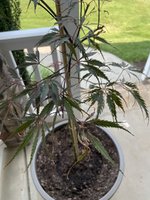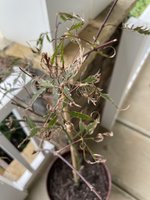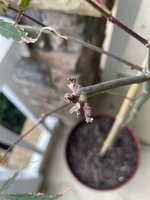Buckle up. I just did a MAJOR brain dump of information below.

I just re-read your original post to see if you mentioned the height of this Japanese maple (JM), but noticed something I missed at first. The fact that you've repotted this thing twice already in just two months, during the peak of summer heat, no less, very likely contributed to the leaves curling up. I'm not saying it was the
only reason, but it certainly might have contributed. I don't know who else it was you asked for help with this issue, but I'd be shocked if someone on here would tell you to repot the tree in the middle of summer after you literally just repotted it a short time before. Repotting in summer is an ill-advised move, especially with young trees that are extra fragile.
More on repotting, I don't know how much you disturbed the roots during these two repots, if at all. Simply taking a plant out of its pot with the root ball intact and putting the whole thing into a larger pot and adding more soil is called "slip-potting." This usually won't bother a plant, and can be done just about anytime of year since you don't disturb the original roots or soil. Removing lots of dirt and exposing the roots in the summer heat however can seriously stress a tree, especially one that can be finicky like lace-leaf cultivars of JM, which the Red Dragon is a type of. With a few exceptions, deciduous trees like JMs are best repotted in late winter/early spring when they're still mostly dormant, just before the buds on the branches open up and new leaves start growing. Again, this is unless you're simply "slip-potting" the tree. If you're messing with the roots at all, don't do it during hot weather. Thankfully, I would guess you didn't cut down the roots at all during repotting (at least you never mentioned doing a root trim), and you repotted into quality soil.
In the end, there's many factors that could have contributed to your leaves drying out and curling up. It could have been one of the issues already mentioned, or a combination. As far as the fertilizing goes, brand new bags of good potting soil usually have some slow-release fertilizer in them already. Typically enough to feed the plant anywhere from one to three months. The first time you repotted it, you added fertilizer to soil that likely already had fertilizer in it. You also may have added too much fertilizer. Plants can get what is called "fertilizer burn", which is the term for when there's too high a concentration of nitrogen salts (nitrogen salt being an ingredient in most fertilizers) in the soil and it causes the leaves to appear burnt and dried out. Again, I'm not 100% sure this was the cause, but it could have been a factor.
As someone who also lives in zone 8 and owns lace-leaf Japanese maples, I can tell you that you're going to have a hard time keeping that tree in peak health at first. It'll take you some time to learn how much sun the tree can handle, how much water it needs, how much fertilizer to use, etc. I will say that with a few exceptions, lace-leaf JM cultivars are not usually used for bonsai, especially by beginners. They tend to be more "weepy" looking in their overall growth habit, which you don't see much in maple bonsai. JM bonsai trees have horizontal or slightly upright angled branches. Just do a Google image search for "Japanese maple bonsai" and you'll see exactly what I mean.
Anyway, putting the problems aside, let's talk about the future of this particular tree. Considering its young age, you don't need to think about its bonsai future just yet. You have some time for that. For the rest of this year, I would just make sure that you don't cook it in the sun any more, don't add any fertilizer to the soil, and keep it watered, but just moist, not muddy or soaking. Japanese maples also like well-draining soil, which typical potting soil doesn't do very well. Organic potting soil like the stuff you bought holds onto water VERY well. Overwatering plants is just as much a novice mistake as underwatering them, and maybe even more dangerous. Wait for the soil to be almost completely dry throughout the whole pot, then water it really well. You want to see water dripping out the drain holes in the bottom of the pot to know you've moistened all the soil. Then let it almost dry out again and repeat. During summer, watch the water level extra carefully from June through August through. Small pots dry out way faster than large pots, and you may need to water every other morning in the dead heat of summer. You'll learn quickly how long it takes for the soil to dry out.
As far as repotting next spring, it's hard to tell from your pictures, but the tree
might need to be put into a slightly larger pot. If it survives the winter, it'll grow well next year as long as you care for it properly. The roots will need space to grow and send more water and nutrients to all those new branches and leaves, which will then help thicken the trunk. While I wouldn't leave a lace-leaf JM in full sun all summer in our growing zone, I wouldn't leave it in full shade either. A few hours of morning sun is good, then let it enjoy shade the rest of the day. You could also keep it under a sun reduction screen like nurseries use, but I don't know how much yard space you have at your place. If you do end up putting it into a larger pot, I recommend a terracotta bulb pot such as this:
https://www.lowes.com/pd/Pennington-8-267-in-W-x-4-25-in-H-Clay/1001005656 This type of pot is wide, but also relatively shallow, which will help you develop a more flattened out root system compared to using a deep nursery pot. As far as the specifics for developing roots, that's a whole other thread, and plenty of those already exist in these forums. Just wait till you learn about flats, pond baskets, grow boxes, floor tiles and plywood squares, etc.
Finally, just remember that at this stage of the tree's bonsai journey, priority one is health, then root base (aka, the "nebari") and trunk size. Like I said earlier, this isn't the best cultivar of JM for you to start with, but one thing that all plants share is the need for good health. After you bring this one back to a good place, you'll be ready to expand your collection of material and really start working on those bonsai skills. If you want to stick with Japanese maples, I recommend the standard, which is simply
Acer palmatum with no cultivar name after it. They're usually just called "green" or "red" Japanese maples at nurseries and big-box stores. They're fast growers, and tolerate full sun WAY better than pretty much any lace-leaf cultivar does. You can also look into Trident Maple trees. They're hardier than JMs, and are great for beginners. If you want to try something other than a maple, I can recommend dwarf crape myrtles. They grow like weeds in the Carolinas and are very hardy, fast-growing little trees that already have smaller leaves, which you want in a bonsai. For an evergreen suggestion, junipers are always a good choice. They're available literally anywhere and don't cost a ton of money for the ones you'd find at nurseries or the big-box stores.
Good luck!












